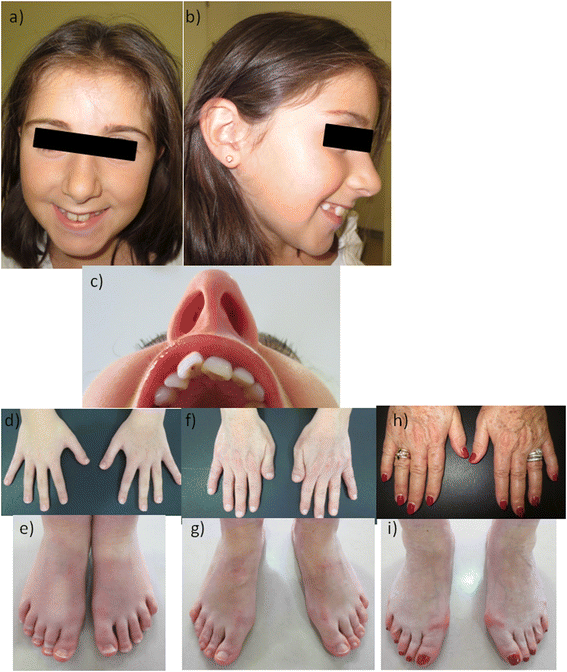First case report of inherited Rubinstein-Taybi syndrome associated with a novel EP300 variant
- PMID: 27964710
- PMCID: PMC5154174
- DOI: 10.1186/s12881-016-0361-8
First case report of inherited Rubinstein-Taybi syndrome associated with a novel EP300 variant
Abstract
Background: Rubinstein-Taybi syndrome (RSTS; OMIM #180849, #613684) is a rare autosomal dominant genetic condition characterized by broad thumbs and halluces, facial dysmorphism, short stature and variable degree of intellectual disability. RSTS is associated with mutations in CREBBP and EP300 genes in 50-60% and 5-8% of cases, respectively. The majority of cases are de novo heterozygous mutations.
Case presentation: Here we describe a familial RSTS case, associated with a novel EP300 mutation. The proband was a 9 years old female, with mild learning difficulties. Her mother, who also had learning difficulties, was found to have short and broad thumbs. MLPA and panel-based NGS of CREBBP and EP300 were performed. A novel heterozygous frameshift mutation in exon 31 of the EP300 gene (c.7222_7223del; p.(Gln2408Glufs*39)) was found in both.
Conclusions: This case represents the first case of inherited EP300-RSTS. The location of the frameshift deletion not affecting HAT domain and PHD finger, could explain the mild phenotype and the well-preserved intelligence. These patients are mildly affected, and this case highlights the possible missed diagnosis. We would recommend molecular testing of apparently healthy parents, and in the case of inherited mutations, of all adult first degree relatives at risk.
Keywords: Case report; EP300; Familial-RSTS; Inheritance; RSTS; Rubinstein-Taybi syndrome.
Figures

Similar articles
-
Rubinstein-Taybi 2 associated to novel EP300 mutations: deepening the clinical and genetic spectrum.BMC Med Genet. 2018 Mar 5;19(1):36. doi: 10.1186/s12881-018-0548-2. BMC Med Genet. 2018. PMID: 29506490 Free PMC article.
-
De novo variation in EP300 gene cause Rubinstein-Taybi syndrome 2 in a Chinese family with severe early-onset high myopia.BMC Med Genomics. 2023 Apr 21;16(1):84. doi: 10.1186/s12920-023-01516-9. BMC Med Genomics. 2023. PMID: 37085840 Free PMC article.
-
Rubinstein-Taybi syndrome in a Saudi boy with distinct features and variants in both the CREBBP and EP300 genes: a case report.BMC Med Genet. 2019 Jan 11;20(1):12. doi: 10.1186/s12881-019-0747-5. BMC Med Genet. 2019. PMID: 30635043 Free PMC article.
-
Rubinstein-Taybi syndrome: clinical features, genetic basis, diagnosis, and management.Ital J Pediatr. 2015 Jan 20;41:4. doi: 10.1186/s13052-015-0110-1. Ital J Pediatr. 2015. PMID: 25599811 Free PMC article. Review.
-
Genotype-phenotype analysis of ocular findings in Rubinstein-Taybi syndrome - A case report and review of literature.Ophthalmic Genet. 2024 Feb;45(1):51-58. doi: 10.1080/13816810.2023.2196341. Epub 2023 Apr 5. Ophthalmic Genet. 2024. PMID: 37017262 Review.
Cited by
-
Exploring by whole exome sequencing patients with initial diagnosis of Rubinstein-Taybi syndrome: the interconnections of epigenetic machinery disorders.Hum Genet. 2019 Mar;138(3):257-269. doi: 10.1007/s00439-019-01985-y. Epub 2019 Feb 26. Hum Genet. 2019. PMID: 30806792 Free PMC article.
-
Rubinstein-Taybi 2 associated to novel EP300 mutations: deepening the clinical and genetic spectrum.BMC Med Genet. 2018 Mar 5;19(1):36. doi: 10.1186/s12881-018-0548-2. BMC Med Genet. 2018. PMID: 29506490 Free PMC article.
-
p300 in Cardiac Development and Accelerated Cardiac Aging.Aging Dis. 2020 Jul 23;11(4):916-926. doi: 10.14336/AD.2020.0401. eCollection 2020 Jul. Aging Dis. 2020. PMID: 32765954 Free PMC article. Review.
-
A novel CREBBP mutation and its phenotype in a case of Rubinstein-Taybi syndrome.BMC Med Genomics. 2022 Aug 19;15(1):182. doi: 10.1186/s12920-022-01335-4. BMC Med Genomics. 2022. PMID: 35986282 Free PMC article.
-
Bi-allelic TTC5 variants cause delayed developmental milestones and intellectual disability.J Med Genet. 2021 Apr;58(4):237-246. doi: 10.1136/jmedgenet-2020-106849. Epub 2020 May 21. J Med Genet. 2021. PMID: 32439809 Free PMC article.
References
Publication types
MeSH terms
Substances
LinkOut - more resources
Full Text Sources
Other Literature Sources
Miscellaneous

